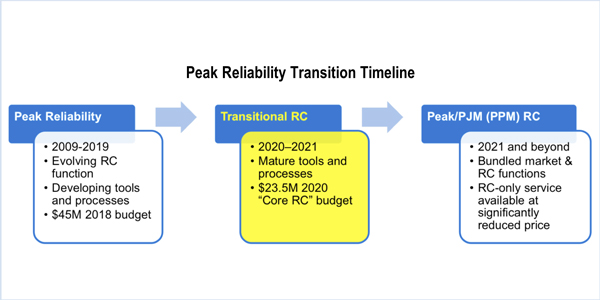By Jason Fordney
Peak Reliability last week outlined a vision for reworking its current structure and reducing costs as it tries to prevent a mass exodus of customers to CAISO.
The reliability coordinator (RC) said the cost reduction will require reducing the size of its board of directors to three members from six, cutting executive jobs, and eliminating some manual and administrative processes. Its current membership and board would need to approve the changes. Peak has been an RC since 2009 and had a $45 million budget for 2018.
After Peak announced last year it would attempt to establish a West-wide energy market in a partnership with PJM, CAISO said it would depart the organization to become its own RC and offer the services to other utilities in the West. (See Peak/PJM Enter Western Market ‘Commitment Phase’.)
An RC provides member utilities services that help them meet NERC standards and requirements, and is entirely different from a market operator. Choosing Peak as an RC would not prevent an entity from joining CAISO’s market, and vice versa.
Peak said its funding amount will fall to $28.7 million if CAISO leaves and all other funders stay; it would be $31.2 million if CAISO remains with Peak under the transitional structure. If CAISO departs, remaining members would see a 10% cost reduction under the transitional RC, but if the ISO remains, all members would see a 30% cost reduction.
Peak spokeswoman Rachel Sherrard told RTO Insider that “the [transitional RC] is not a separate organization. It is how Peak would be structured and funded post 2019. It is not a dramatic change in terms of the tools and services that we as the RC currently provide.”
When asked last week about the likelihood of CAISO remaining with Peak, ISO spokesman Steven Greenlee said, “We are moving ahead with our plans to become a RC and offer those services to other entities in the West.”
Peak would operate under the transitional RC structure in 2020/21 and have a $23.5 million operating budget for 2020. It would offer core RC services that ensure reliability and meeting NERC standards, as well as optional services such as Hosted Advanced Applications and the WECC Interchange Tool, which validates E-Tags and confirms power transactions throughout the region. It would also offer interconnection-shared services that support reliability in the West, such as the Reliability Messaging Tool and Enhanced Curtailment Calculator.
After 2021, Peak and PJM would offer bundled market and RC functions, as well as RC-only services at a reduced price.
Peak CEO Marie Jordan last week provided stakeholders a presentation explaining the transitional structure. She also sent an April 27 letter to the organization’s funding parties, member advisory committee and reliability member representatives, touting its experience maintaining reliability of the entire Western Interconnection.
“Over the past decade, in collaboration with its stakeholders, Peak Reliability has built and operated that RC,” Jordan said in the letter. “CAISO has not. SPP has not.”
Peak said it will issue a straw proposal on May 21 that will describe how the transitional structure could be implemented.
CAISO said it expects to begin shadow operations with Peak in May 2019 and become the RC of record for its balancing authority by the end of June 2019.




